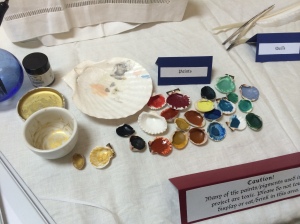
Pigments available to the medieval/renaissance illuminator included mineral and organic ones. The typical palette consisted of:
- Black: from lamp soot, charred bone, other carbon sources (e.g. vine black, made from charred grape vines)
- White: lead white; Cennini specifically mentions that other sources of white, such as chalk, have limited value to the artist
- Browns: typically from various earth sources such as umber
- Yellows: orpiment (arsenic sulphide), various ochres/earths, tin, saffron
- Greens: verdigris (copper acetate produced via various chemical reactions), some earths, malachite (a mineral that also derives its color from copper)
- Blues: lazurite (lapis lazuli, which yielded the expensive and desirable ultramarine blue), azurite, some copper compounds (including some forms of verdigris), indigo
- Purple: turnsole
- Reds: madder, minium (lead oxide), vermilion (cinnabar / mercuric sulphide), possibly kermes and cochineal
Continue reading “Making Your Own Paints: A Beginner’s Guide”



